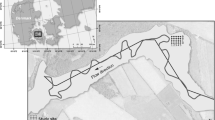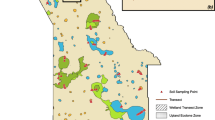Abstract
Redox potential impacts wetland ecosystem functions and processes. This study assessed the temporal and spatial patterns and variability of soil redox potential in relation to: 1) hydrology, 2) soil phosphorus (P) enrichment, and 3) dominant vegetation community in an Everglades wetland. Probes installed for 2-week periods required 8 to 10 days for measurements to stabilize, considerably longer than what has been reported in the literature. Probes installed for 1 year yielded more stable measurements and were more useful for ecological analysis. Redox temporal patterns were related to water table fluctuation with redox increasing exponentially as the water table decreased from 5 cm above marsh surface. Large-scale spatial redox patterns were found in relation to P enrichment with higher average redox occurring in moderately-enriched regions (−134 mV) than in highly-enriched or unenriched regions (−185 mV for both). Vegetation community had no effect on redox status. Water level change was the primary driver of small-scale spatial variability (soil profile) with redox measurements varying more near the marsh surface during low water conditions. The degree of redox response to water table fluctuation decreased with increasing soil depth. These findings are important in understanding how altering hydrology can affect soil processes and ecosystem function.
Similar content being viewed by others
Literature cited
Atlas, R. M. and R. Bartha. 1993. Microbial ecology: fundamentals and applications, third edition. The Benjamin/Cumings Publishing Company, Inc., Redwood City, CA, USA.
Austin, W. E. and J. H. Huddleston. 1999. Viability of permanently installed platinum redox electrodes. Soil Science Society of America Journal 63:1757–62.
Chabbi, A., K. L. McKee, and I. A. Mendelssohn. 2000. Fate of oxygen losses fromTypha domingensis (Typhaceae) andCladium jamaicense (Cyperaceae) and consequences for root metabolism. American Journal of Botany 87:1081–90.
Cogger, C. G., P. E. Kennedy, and D. Carlson. 1992. Seasonally saturated soils in the Puget lowland. 2. Measuring and interpreting redox potentials. Soil Science 154:50–58.
Craft, C. B. and C. J. Richardson. 1993. Peat accretion and N, P, and organic C accumulation in nutrient-enriched and unen-riched Everglades peatlands. Ecological Applications 3:446–58.
Davis, S. M. 1989. Sawgrass and cattail production in relation to nutrient supply in the Everglades, p. 325–341.In R. R. Sharitz and J. W. Gibbons (eds.) Freshwater Wetlands and Wildlife. Office of Scientific and Technical Information, U.S. Department of Energy, Oak Ridge, TN, USA.
Davis, S. M. 1991. Growth, decomposition and nutrient retention ofCladium-jamicense Crantz andTypha-domingensis Pers in the Florida Everglades. Aquatic Botany 40:203–24.
de Mars, H. and M. J. Wassen. 1999. Redox potentials in relation to water levels in different mire types in the Netherlands and Poland. Plant Ecology 140:41–51.
Debusk, W. F. and K. R. Reddy. 2005. Litter decomposition and nutrient dynamics in a phosphorus enriched Everglades marsh. Biogeochemistry 75:217–40.
Eshel, G. and A. Banin. 2002. Feasibility study of long-term continuous field measurement of soil redox potential. Communications in Soil Science and Plant Analysis 33:695–709.
Fiedler, S., M. J. Vepraskas, and J. L. Richardson. 2007. Soil redox potential: importance, field measurements, and observations. Advances in Agronomy 94:1–54.
Gambrell, R. P. and J. W. H. Patrick. 1978. Chemical and microbiological properties of anaerobic soils and sediments. p. 375–423. In D. D. Hook and R. M. M. Crawford (eds.) Plant Life in Anaerobic Environments. Ann Arbor Scientific Publishing, Inc., Ann Arbor, MI, USA.
Howes, B. L., R. W. Howarth, J. M. Teal, and I. Valiela. 1981. Oxidation-reduction potentials in a salt-marsh—spatial patterns and interactions with primary production. Limnology and Oceanography 26:350–60.
Laskov, C., O. Horn, and M. Hupfer. 2006. Environmental factors regulating the radial oxygen loss from roots ofMyriophyHum spicalum and Polamogelon crispus. Aquatic Botany 84:333–40.
Mansfeldt, T. 2003. In situ long-term redox potential measure-ments in a dyked marsh soil. Journal of Plant Nutrition and Soil Science-Zeitschrift Fur Pflanzenernahrung Und Bodenkunde 166:210–19.
Megonigal, J. P., S. P. Faulkner, and J. W. H. Patrick. 1996. The microbial activity season in southeastern hydric soils. Soil Science Society of America Journal 60:1263–66.
Miao, S., S. Carstenn, C. Thomas, C. Edelstein, E. Sindhoj, and B. Gu. 2009. Integrating multiple spatial controls and temporal sampling schemes to explore short- and long-term ecosystem response to fire in an Everglades wetland, p. 73–110.In S. Miao, S. Carstenn, and M. Nungesser (eds.) Real World Ecology, Large-Scale and Long-Term Case Studies and Methods. Springer Science + Business Media, New York, NY, USA.
Moore, P. A. and K. R. Reddy. 1994. Role of Eh and pH on phosphorus geochemistry in sediments of Lake Okeechobee, Florida. Journal of Environmental Quality 23:955–64.
Newman, S., J. B. Grace, and J. W. Koebel. 1996. Effects of nutrients and hydroperiod onTypha, Cladium, and Eleocharis: implications for Everglades restoration. Ecological Applications 6:774–83.
Niedermeier, A. and J. S. Robinson. 2007. Hydrological controls on soil redox dynamics in a peat-based, restored wetland. Geoderma 137:318–26.
Pezeshki, S. R., R. D. DeLaune, H. K. Kludze, and H. S. Choi. 1996. Photosynthetic and growth responses of cattail (Typha domingensis) and sawgrass (Cladium jamaicen.se) to soil redox conditions. Aquatic Botany 54:25–35.
Quails, R. G., C. J. Richardson, and L. J. Sherwood. 2001. Soil reduction-oxidation potential along a nutrient-enrichment gradient in the Everglades. Wetlands 21:403–11.
Seybold, C. A., W. Mersie, J. Y. Huang, and C. McNamee. 2002. Soil redox, pH, temperature, and water-table patterns of a freshwater tidal wetland. Wetlands 22:149–58.
Weisner, S. E. B. and S. L. Miao. 2004. Use of morphological variability inCladium jamaicen.se andTypha dotningensis to understand vegetation changes in an Everglades marsh. Aquatic Botany 78:319–35.
Yang, J., Y. M. Hu, and R. C. Bu. 2006. Microscale spatial variability of redox potential in surface soil. Soil Science 171:747–53.
ZoBell, C. E. 1946. Studies on redox potential of marine sediments. Bulletin of the American Association of Petroleum Geologists. 30:477–513.
Author information
Authors and Affiliations
Corresponding author
Rights and permissions
About this article
Cite this article
Thomas, C.R., Miao, S. & Sindhoj, E. Environmental factors affecting temporal and spatial patterns of soil redox potential in Florida Everglades wetlands. Wetlands 29, 1133–1145 (2009). https://doi.org/10.1672/08-234.1
Received:
Accepted:
Issue Date:
DOI: https://doi.org/10.1672/08-234.1




